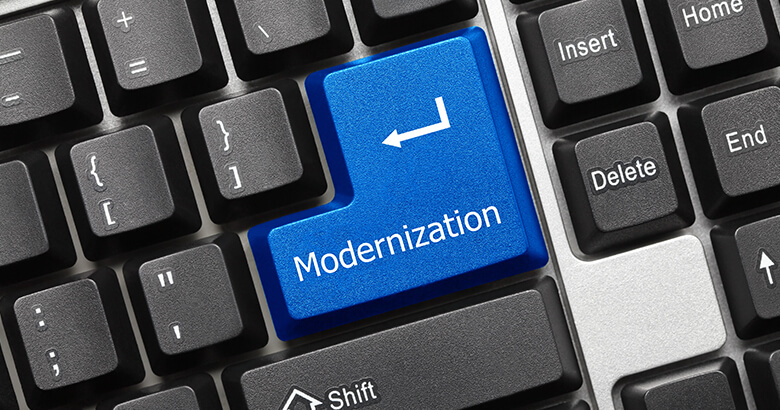Modernize or Else?

Legacy modernization is a necessity for companies wanting to improve their services and to provide the fastest possible access to information. Driven by the need for an agile infrastructure that supports both old and new, and the ability of digital services to meet both short and long term business strategies and goals, many CIOs, CSOs, CTOs and infrastructure leaders will have modernization at the top of their agendas again this year.
As IDG describes it, digital transformation is the use of 3rd platform technologies to create value and competitive advantage through new offerings, new business models, and new relationships[1].
According to the IDG State of Digital Transformation Report, organizations say their biggest obstacles in achieving success with digital business initiatives include lack of sufficient budget (39%), lack of staff and/or correct skill sets (36%), the need to replace legacy systems (34%), and cultural issues (33%). Additionally, IDG noted more than a third of organizations (44%) have already started implementing a digital-first approach to business processes, operations and customer engagement. Some 19% are in the integration process of making operational and technology changes throughout the enterprise, and 18% are executing their digital plans and making process, operational and technology changes on a department and business unit level. Just 7% of companies have already fully implemented their digital first approach and are in the maintenance phase.
Dated legacy strategies aren’t ready for change
Today’s enterprises and organizations face a widening divergence between the IT infrastructure demanded by new business needs and the infrastructure they’ve piled up over several years. According to the insider report Global Application Modernization Services Market, broadcast by KBV research, the Global Application Modernization Services Market measurement is predicted to make it to $17.7 billion by 2023. That being said, modernization is here is to stay[2].
Software, web applications, and enterprise systems are faster, leaner, and easier to use than ever before. They can crunch more big data, can be backed up at the drop of a hat, are more secure, and have the ability to be housed in the cloud. An organization can easily fall behind a competitor that is using a newer system that allows them to run faster and more effectively.
Outdated technology and systems threaten the security of your organization and your customers
If you’ve worked in data security or software, you know this to be true. Security is based largely on the concept of lean IT; continuous changes made to stop the latest threats; and being reactive rather than proactive. Legacy systems by their nature struggle with this. Certain vulnerabilities may not be as easy to fix due to the large, inflexible nature of older systems. Even if there is a solution, the patch is typically stalled at some point because it is much more difficult for developers to create a legacy fix – and it’s lower on the priority list. As a result, after a period of safety, legacy systems enter a phase where they are a danger to the company and its customers.
Smart enterprises meet these challenges by replacing outdated managed file transfer and B2B technology, systems and services with digitally enabled, modern, secure, trustworthy, agile, and scalable hybrid integration platforms that can be deployed on-premises or in any cloud environment.
Start planning your legacy migration
New, digital applications are less complex and highly customizable. Modernized applications and systems offer increased capabilities and can be accessed and maintained from anywhere. In addition, the automated processes of well-integrated applications are easy to maintain, so you likely won’t suffer from a resource crisis for maintaining them. Here are a few questions to ask yourself to determine your organization’s need for legacy modernization:
- How do you guarantee that data from your core applications is consolidated and used correctly for mobile and digital services?
- Do you need to invest large amounts of time and effort into developing data mapping process and work flow orchestration to provide real-time data?
- Do you need centralized reporting, governance and secure data store for all workflows?
- Are you confident your infrastructure can withstand critical upgrades in your environment?
The benefits stem from
- replacing disparate, fragmented and departmental silo’d systems with a single, agile, modern platform that integrates EDI, B2B, API and managed file transfer functions;
- eliminating legacy integration technologies that require multiple patch upgrades and ongoing fixes to support new protocols and comply with evolving regulatory and governance requirements;
- and leveraging newer technology to provide end-to-end visibility of all B2B and file exchange processes for easy tracking by business users without IT intervention.
Learn more about Legacy Modernization.
[1] State of Digital Business Transformation, IDG, 2018
[2] Global Application Modernization Services Market, KBV Research.
Thank you for your message
We appreciate your interest in SEEBURGER
Get in contact with us:
Please enter details about your project in the message section so we can direct your inquiry to the right consultant.
Written by: Ulf Persson
As SVP Strategic Product Management and Analyst Relations, Ulf is responsible for strategic product management, product marketing, global analyst relations and leadership with regards to SEEBURGER integration technology, platform and integration services. This also includes strategic sales and marketing initiatives. Ulf works across multiple industry verticals such as Financial Services/Payments, Automotive, Logistics, Utilities, Retail, CPG and Manufacturing. Ulf has more than 30 years of global business and technology experience working with product and solution delivery of integration technologies (EAI, EDI, B2B, MFT, API, etc.), Analytics and Big Data, Cloud Services, Digital Transformation and various industry initiatives. Before joining SEEBURGER in October 2016, Ulf worked in various global leadership roles with international business integration technology and cloud services providers.





